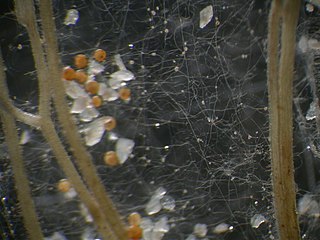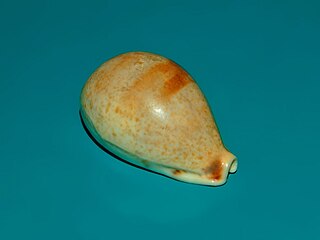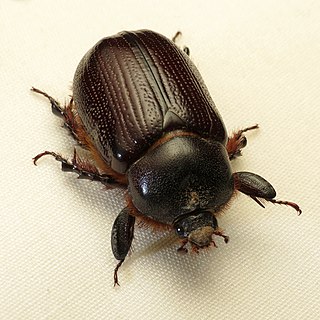
Glomeromycota are one of eight currently recognized divisions within the kingdom Fungi, with approximately 230 described species. Members of the Glomeromycota form arbuscular mycorrhizas (AMs) with the thalli of bryophytes and the roots of vascular land plants. Not all species have been shown to form AMs, and one, Geosiphon pyriformis, is known not to do so. Instead, it forms an endocytobiotic association with Nostoc cyanobacteria. The majority of evidence shows that the Glomeromycota are dependent on land plants for carbon and energy, but there is recent circumstantial evidence that some species may be able to lead an independent existence. The arbuscular mycorrhizal species are terrestrial and widely distributed in soils worldwide where they form symbioses with the roots of the majority of plant species (>80%). They can also be found in wetlands, including salt-marshes, and associated with epiphytic plants.

Nepenthes × pyriformis is a natural hybrid involving N. inermis and N. talangensis. It is known only from Mount Talang in Sumatra, to which N. talangensis is endemic. Nepenthes talangensis was only described as a distinct species in 1994. Prior to this it was placed within N. bongso and some of the older literature identifies this hybrid as N. bongso × N. inermis.

Mischocarpus is a genus of about nineteen species of trees known to science, constituting part of the plant family Sapindaceae. They grow naturally from Australia and New Guinea, though Malesia as far north as the Philippines, through SE. Asia, Indo-China and S. China, to India at their farthest west. The eleven Australian species known to science grow naturally in the rainforests of the eastern coastal zone of New South Wales and Queensland, from Newcastle northwards through to north-eastern Queensland and Cape York Peninsula.

Eucalyptus pyriformis, commonly known as pear-fruited mallee or Dowerin rose, is a species of low, straggly mallee that is endemic to Western Australia. It has smooth greyish brown bark sometimes with ribbony bark near the base, egg-shaped to lance-shaped adult leaves, flower buds in groups of three, red, pinkish or creamy white flowers and down-turned, conical fruit with prominent ribs.

Cariniana pyriformis is a species of woody plant in the family Lecythidaceae. It is found in Brazil, Colombia, Costa Rica, and Venezuela. It is threatened by habitat loss.

Eugenia pyriformis is a plant of the family Myrtaceae found primarily in Brazil. It reaches 20 to 45 feet in height and 1 to 1.5 feet in trunk diameter. It is a native species of Brazil, occurring primarily in the states of Paraná, Rio Grande do Sul, Santa Catarina and São Paulo.
Trimastix is a genus of excavates, the sole occupant of the order Trimastigida. Trimastix are bacterivorous, free living and anaerobic. When first observed in 1881 by William Kent, the morphology of Trimastix was not well described but over time the oral structure and flagellar organization have become clearer. There are few known species, and the genus's role in the ecosystem is largely unknown. However, it is known that they generally live in marine environments within the tissues of decaying organisms to maintain an anoxic environment. Much interest in this group is related to its close association with other members of Anaeromonadea. Like other members of this order, these organisms do not have classical mitochondria. As such, much of the research involving these microbes is aimed at investigating the evolution of mitochondria.

Encyclia pyriformis is a species of orchid.

Erronea pyriformis, common name the pear-shaped cowrie, is a species of sea snail, a cowry, a marine gastropod mollusk in the family Cypraeidae, the cowries.

Myrmecia pyriformis, also known as the bull ant or inch ant, is an Australian ant. Myrmecia pyriformis belongs to the genus Myrmecia. It is abundant in many major cities of Australia, but mostly spotted in the eastern states. The species is of a similar appearance to the Myrmecia forficata.
Orizabus mcclevei is a species of rhinoceros beetle in the family Scarabaeidae. It is found in North America.

Orizabus is a genus of rhinoceros beetles in the family Scarabaeidae. There are about 10 described species in the genus Orizabus.
Orizabus pinalicus is a species of rhinoceros beetle in the family Scarabaeidae. It is found in North America.
Orizabus clunalis is a species of rhinoceros beetle in the family Scarabaeidae. It is found in North America.
Orizabus ligyroides is a species of rhinoceros beetle in the family Scarabaeidae. It is found in North America.
Celticecis is a genus of hackberry gall midges in the family Cecidomyiidae. There are about 18 described species in Celticecis.

Protenor is a genus of broad-headed bugs in the family Alydidae. There are at least three described species in Protenor.

Eurhoptus pyriformis is a species of hidden snout weevil in the beetle family Curculionidae. It is found in North America.

Protopulvinaria pyriformis, commonly known as the pyriform scale, is a species of soft scale insect in the family Coccidae. It is a pest of avocado and is found in many countries around the world where avocados grow.












